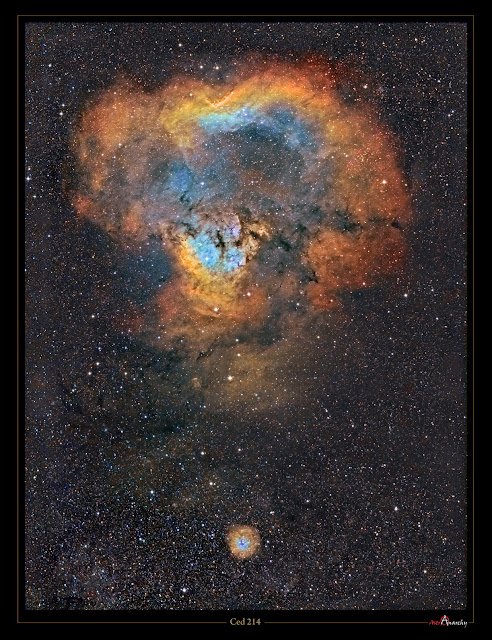COPYRIGHT, PLEASE NOTE
All the material on this website is copyrighted to J-P Metsavainio, if not otherwise stated. Any content on this website may not be reproduced without the author’s permission.
BUY A MUSEUM QUALITY POSTER
BUY A POSTER:https://astroanarchy.zenfolio.com/
Sunday, February 12, 2012
AstroAnarchy gets published
![[nasa-large.jpg]](https://blogger.googleusercontent.com/img/b/R29vZ2xl/AVvXsEhnPTKmnidt6gHuVkChO_MPYTqp2lSu-Tr0If3ey1qfJxF9BJpDhG8wIWnxo86hb3vT5OYKiznVUminjBaRRat99o70A1ODvDjHEDHpKGWYCsnjn-WFYunaGVPsfXiizriH0upX9hbpNWs/s1600/nasa-large.jpg)
At Fridays APOD, Feb. 10. 2012, NASA writers used my experimental 3D-stereo pair of NGC 6752 as a reference.
Link to this APOD: http://apod.nasa.gov/apod/ap120210.html
My stereo pair from the same object is as a text link , "stars in a sphere", in an APOD above.
Labels:
publications
Saturday, February 11, 2012
Ced 214 as a 3D stereo pair
Ones again, I have done my 3D-experiments with astronomical images.
Viewing instructions can be seen here:
http://www.astroanarchy.blogspot.com/search/label/Stereo%20image%20viewing%20instructions
Parallel vision format
Cross vision format
Other 3D-formats:
Original 2D:
NOTE! This is a personal vision about forms and shapes, based on some known facts and an artistic impression.
Labels:
stereo images
CED 214 as an anaglyph Red/Cyan 3D
3D-NOTE!
You'll need Red/Cyan Eyeglasses to be able to see images as 3D.If you have a Red and Blue filters, you can use them! Red goes to Left eye.
An experimental 3D-study in anaglyph format
Other 3D-formats:
Original 2D:

NOTE! This is a personal vision about forms and shapes, based on some known facts and an artistic impression.
Labels:
anaglyph images and movies
Wednesday, February 8, 2012
Siemis 147, new data added
I did reprocess this SNR, since I have now new data to add,
Emission of an Oxygen III 5h, and emission of Hydrogen II 5h
Total exposure time is now 26h. with fast, Canon EF 200mm f1.8, camera optics.
Simeis 147, Sh2-240
In constellation Taurus
Image is in mapped colors, from the emission of ionized elements, R=Sulfur, G=Hydrogen and B=Oxygen.
Note. New data for O-III has added much more blue color.
Older version can be seen in this blog post:
http://astroanarchy.blogspot.com/2011/12/simeis-147-supernova-remnant.html
Older version can be seen in this blog post:
http://astroanarchy.blogspot.com/2011/12/simeis-147-supernova-remnant.html
I shot H-alpha filtered lights for this image at many nights, after I shot lights for my Cygnus mosaic project.
After a midnight, Cygnus and its targets are too low in the horizon so I used rest of the night for this supernova remnant. Total exposure time for H-alpha is now ~18h +5h of an additional O-III light.
Simeis 147 (sharpless 240), is a very faint and very large supernova remnant in constellation Taurus at distance of ~3000 light years. It's constantly expanding at speed of 1000 km/second but due the size of it, we can't see any movement in it. This SN spans over 160 light years and the apparent scale in the sky is about three degrees (Moon has an apparent size of 30" = 0,5 degrees). Explosion took place approximately 30.000 years ago and left behind a pulsar (Neutron star). The pulsar has recently identified.
How long it'll takes to this supernova remnant to expand 1% large when the diameter is 160 light years and it expands at speed of 1000km/second.
How long it'll takes to this supernova remnant to expand 1% large when the diameter is 160 light years and it expands at speed of 1000km/second.
Answer is ~480 years.
(1% of diameter 160/100= 16, as kilometers ~151.372.800.000.00, = Y, km,
1000km/second is ~315.360.000.00, = Z, kilometers/year.
So, X x Z = Y and X=Z/Y, X = 480 with given values)
(1% of diameter 160/100= 16, as kilometers ~151.372.800.000.00, = Y, km,
1000km/second is ~315.360.000.00, = Z, kilometers/year.
So, X x Z = Y and X=Z/Y, X = 480 with given values)
This is a difficult target to image and image above is my second try to capture it. An older version can be seen here. This older image was my second APOD from NASA.
EDIT.
This image get selected as a Space Picture of the Week by the National Geographic magazine.
You can see the story HERE
Closeups
Image in visual spectrum
R=Hydrogen + Sulfur, G=Oxygen and B=Oxygen + Hydrogen.
This palette is very close to a visual spectrum.
An animated image, with and without stars
Technical details:
Processing work flow:
Image acquisition, MaxiDL v5.07.
Stacked and calibrated in CCDStack2.
Deconvolution with a CCDStack2 Positive Constraint, 33 iterations, added at 33 % weight
Levels, curves and color combine in PS CS3.
Optics, Canon EF 200mm camera lens at f1.8
Camera, QHY9
Guiding, Meade LX200 GPS 12" and a Lodestar guider
Image Scale, ~5,5 arcseconds/pixel
H-alpha 34x900s, Binned 1x1 = 8,5h
H-alpha 24x1800s, Binned 1x1 = 12h
O-III 60 x 300s, Binned 3x3 = 5h
S-II 6 x 600, Binned 3x3 = 1h
Total exposure time for Hydrogen alpha alone is ~20,5h
Total exposure time is 26,5h
Part of the O-III and S-II channel are from an older image, it can be seen here
Subscribe to:
Posts (Atom)




















